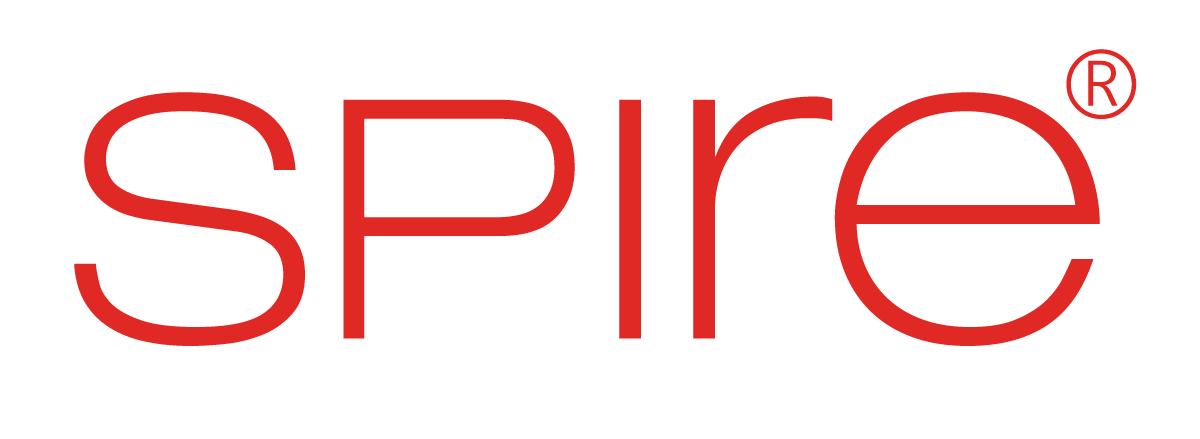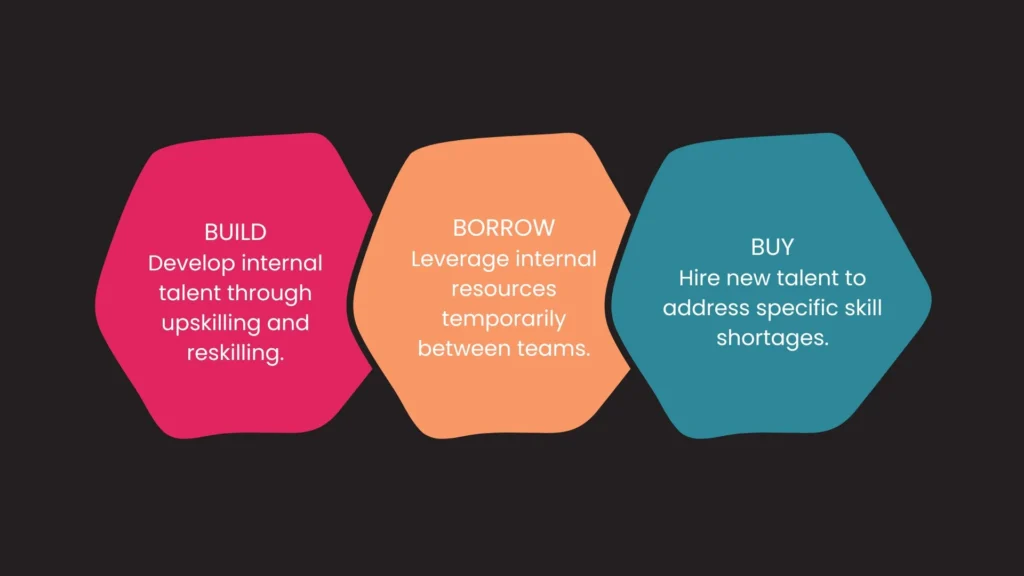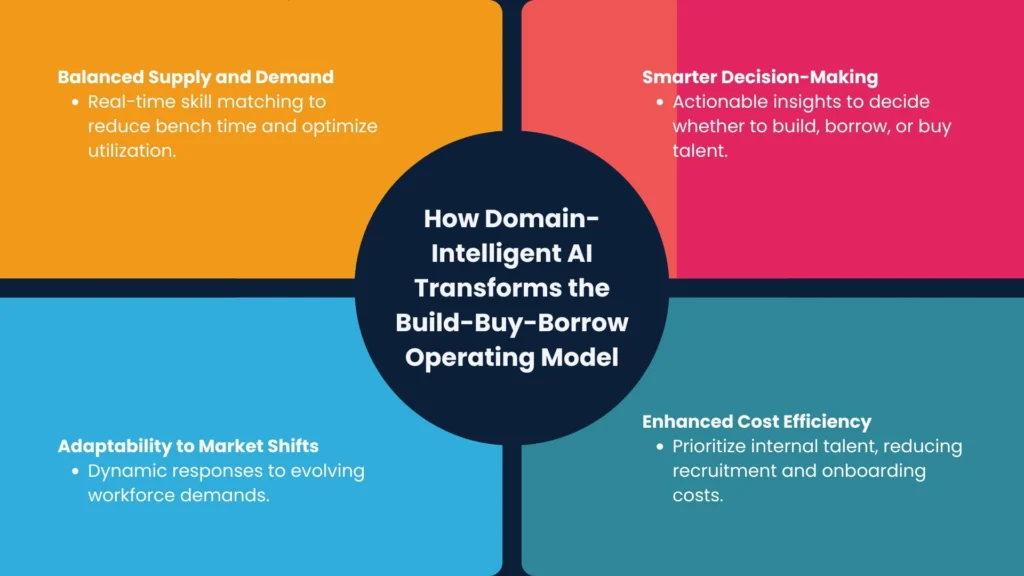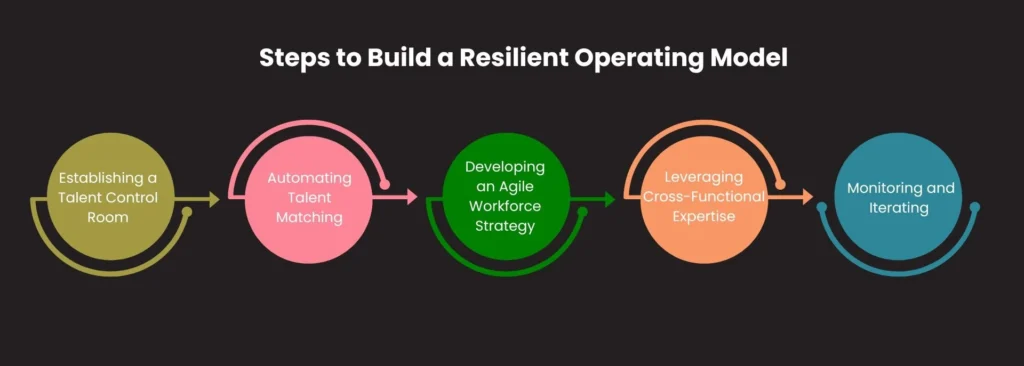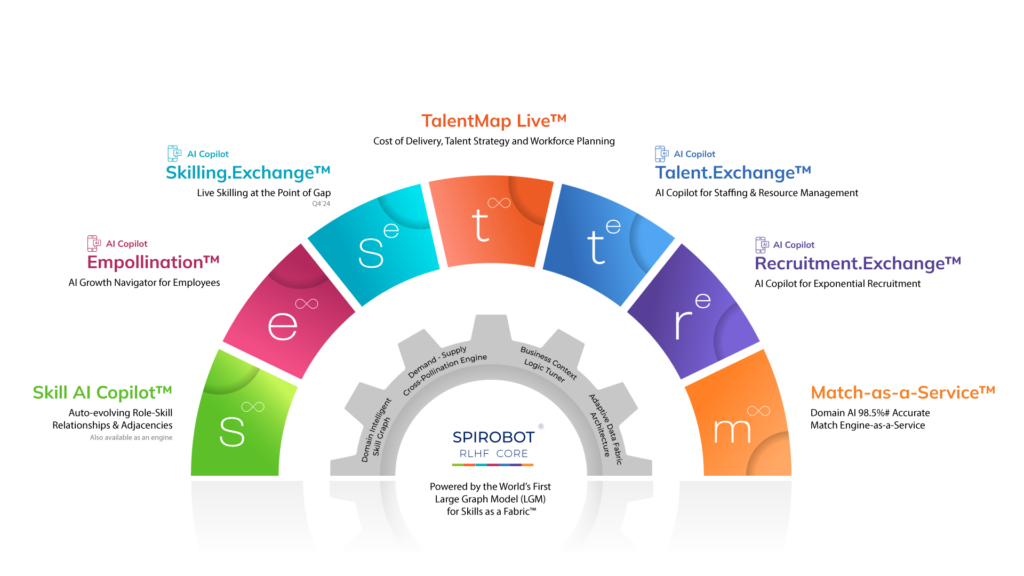This blog explores the Build, Borrow, Buy framework, its key components, and how Domain-Intelligent AI enhances each aspect. It also highlights the role of Spire.AI in helping organizations make smarter, data-driven decisions to build a resilient workforce strategy.
Decoding the Build, Borrow, Buy Framework
The Build, Borrow, Buy framework enables organizations to align talent acquisition and development with evolving business priorities. It allows leaders to decide whether to strategically:
- Build: Develop internal talent through upskilling and reskilling.
- Borrow: Leverage internal resources temporarily between teams.
- Buy: Hire new talent to address specific skill shortages.
Despite its strategic value, many organizations struggle with implementing this framework effectively due to limited visibility into workforce capabilities and future demands. This is where technology, particularly Domain-Intelligent AI, becomes a game-changer.
Enhancing the Build, Borrow, Buy Framework with Domain-Intelligent AI
Domain-Intelligent AI introduces a layer of precision and adaptability previously missing in traditional workforce strategies. By leveraging advanced analytics and real-time data, organizations can make informed decisions across the Build, Borrow, and Buy framework, optimizing talent utilization and operational costs.
1. Building Talent for Long-Term Growth
Investing in existing employees is often the most sustainable and cost-effective approach to bridging skill gaps. However, it requires a robust mechanism to identify skill gaps, map career paths, and create effective learning opportunities.
How Domain-Intelligent AI Supports Building Talent:
- Skill Mapping: AI can analyze employee data to create dynamic skill inventories, identifying gaps and growth opportunities.
- Targeted Development Programs: Personalized learning recommendations ensure employees acquire the skills needed for future demands.
- Employee Retention: Investing in growth opportunities strengthens employee loyalty and reduces turnover.
How Domain-Intelligent AI Supports Building Talent:– Skill Mapping
– Targeted Development Programs
– Employee Retention
2. Borrowing Talent for Flexibility
Short-term talent gaps often require flexible solutions. Through internal redeployment, borrowing talent enables organizations to address immediate needs, such as surges in project demands, without long-term commitments.
How Domain-Intelligent AI Supports Borrowing Talent
- Internal Redeployment: Domain AI identifies underutilized and specialized talent across teams, ensuring optimal allocation to high-priority projects.
- Agility in Response: Organizations can seamlessly adapt to changing project demands by aligning talent quickly.
How Domain-Intelligent AI Supports Borrowing Talent:– Internal Redeployment
– Agility in Response
3. Buying Talent for Strategic Expertise
Hiring new talent becomes essential when specialized skills are required. Traditional hiring processes, however, are often slow and resource-intensive.
How Domain-Intelligent AI Supports Buying Talent
- Predictive Talent Forecasting: Domain-Intelligent AI anticipates future skill requirements, enabling proactive hiring strategies.
- Candidate Matching: Intelligent algorithms evaluate candidates based on skills, potential, and cultural fit, ensuring alignment with organizational needs.
- Efficiency in Hiring: Automated processes reduce time-to-hire and associated costs.’
How Domain-Intelligent AI Supports Buying Talent:– Predictive Talent Forecasting
– Candidate Matching
– Hiring Efficiency
Turning the Build, Borrow, Buy Framework into a Resilient Operating Model
The Build, Borrow, Buy framework offers organizations a flexible approach to managing workforce needs, but its true potential is unlocked when it evolves into a resilient operating model. A resilient model ensures agility, cost-efficiency, and alignment with shifting business demands. This transformation requires strategic technology integration, predictive analytics, and forward-looking workforce planning.
Key Elements of a Resilient Operating Model
To move beyond the traditional framework, organizations must focus on integrating dynamic capabilities that allow them to adapt quickly to both short-term and long-term needs. Here’s how:
-
Real-Time Workforce Visibility
- A resilient operating model requires a unified and real-time view of workforce capabilities. This includes having up-to-date skill inventories, demand forecasts, and resource availability across teams.
- Domain-Intelligent AI enables organizations to maintain a comprehensive, continuously updated employee skills database, allowing instant decision-making and resource allocation.
-
Predictive Workforce Planning
- Predictive analytics transforms workforce planning from reactive to proactive. Organizations can anticipate future talent needs, identify potential skill shortages, and plan interventions before they impact business operations.
- Organizations can seamlessly balance the Build, Borrow, Buy framework to meet dynamic demand by forecasting hiring requirements, training needs, and redeployment opportunities.
-
Seamless Internal Mobility
- Internal mobility reduces hiring costs and boosts employee engagement and retention. A resilient model effectively leverages internal talent, ensuring career paths are well-defined and employees are encouraged to explore opportunities within the organization.
- AI-driven career pathing tools are crucial here, as they match employees to new roles and open demands based on their evolving skills and aspirations.
-
Flexible Talent Allocation
- A static workforce strategy limits an organization’s ability to respond to change. A resilient model supports the fluid movement of talent across projects, departments, or even geographies, minimizing idle resources and maximizing productivity.
- AI-powered cross-unit redeployment ensures the right talent is in the right place at the right time, with minimal delays.
-
Continuous Learning and Development
- Building a workforce capable of meeting future challenges requires continuous upskilling and reskilling. Organizations must embed learning into their operating model, aligning development programs with business goals.
- Domain-Intelligent AI helps personalize learning recommendations, ensuring employees acquire the skills needed for evolving roles.
How Domain-Intelligent AI Transforms the Operating Model
Domain-Intelligent AI amplifies the effectiveness of the Build, Borrow, Buy framework by addressing its inherent limitations. It brings real-time intelligence, adaptability, and precision to workforce strategies, enabling organizations to:
- Balance Supply and Demand: Automatically match skills with demand to reduce bench time and optimize utilization.
- Improve Decision-Making: Provide actionable insights on whether to build, borrow, or buy talent based on real-time and predictive data.
- Enhance Cost Efficiency: Prioritize internal resources over external hires, significantly lowering recruitment and onboarding costs.
- Adapt to Market Shifts: Quickly reallocate resources to meet client needs or project scopes.
Steps to Build a Resilient Operating Model
To operationalize the Build, Borrow, Buy framework effectively, organizations should focus on:
- Establishing a Talent Control Room: Create a centralized hub that provides a real-time view of talent data, including skill inventories, current workloads, and future demands. This helps leaders make informed decisions quickly.
- Automating Talent Matching: Implement AI-driven solutions to automate the alignment of skills with organizational needs, eliminating manual inefficiencies and accelerating response times.
- Developing an Agile Workforce Strategy: Embrace flexible workforce structures that allow for rapid redeployment, temporary staffing solutions, and continuous upskilling to keep the talent pool future-ready.
- Leveraging Cross-Functional Expertise: Resource sharing encourages collaboration between departments and business units. This reduces redundancy and maximizes talent utilization across the organization.
- Monitoring and Iterating: Regularly review workforce metrics, such as utilization rates, skill proficiency levels, and fulfillment times, to identify areas for improvement and refine strategies as needed.
The Role of Spire.AI in the Build, Borrow, Buy Framework
Spire.AI solutions redefine how organizations implement the Build, Borrow, Buy framework by offering a data-driven and automated workforce planning and resource management approach. The platform transforms workforce strategies into efficient, resilient operating models through real-time insights, predictive analytics, and AI-powered decision-making.
How the Platform Supports Building Talent
-
Auto-Evolving Skill Inventories:
- The platform continuously updates role and skill inventories using real-time employee data, ensuring precise visibility into internal capabilities.
- It automatically generates skill profiles for every employee, identifying gaps that can be addressed through focused upskilling or reskilling efforts.
-
Personalized Development and Career Pathing
- The system recommends targeted training and certification opportunities tailored to each employee’s skills and role requirements.
- With career path simulations, employees can align their aspirations with organizational needs, fostering growth and retention.
How the Platform Enables Borrowing Talent
-
Internal Redeployment with Ultra-Scale Matching
- The cross-pollination engine matches available employees with internal project demands, optimizing resource utilization and reducing reliance on external contractors.
- Bi-directional, real-time matching across all demands and supply pools ensures that no talent is left idle.
-
Short-Term Borrowing Across Teams
- The platform facilitates temporary redeployment of talent between departments or business units, minimizing delays in project execution.
How the Platform Optimizes Buying Talent
-
Predictive Talent Forecasting
- The system predicts skill shortages based on upcoming demands, enabling proactive recruitment planning and avoiding last-minute hiring spikes.
-
Efficient External Hiring
- Through its Talent Acquisition module, the platform integrates with ATS systems to streamline external hiring, ensuring quick identification and onboarding of candidates with the right skills.
-
Reduced Cost Per Hire (CPH)
- By automating demand qualification and candidate matching, recruitment costs are reduced, and the hiring process is accelerated, reducing the time it takes to fill critical roles.
Integrated Talent Control Room
The Talent Control Room acts as a centralized hub for workforce management, providing:
- Real-Time Talent Data: Access to skill availability, demand forecasts, and deployment statuses.
- Scenario-Based Decision Support: Automated suggestions for whether to build, borrow, or buy talent based on current and projected needs.
- Demand-Supply Visualization: A comprehensive view of open demands and available resources, enabling faster and more informed decision-making.
Transforming Build, Borrow, Buy into Action
The platform empowers organizations to operationalize the Build, Borrow, Buy framework through intelligent automation and data-driven insights. These solutions reduce costs, enhance agility, and ensure talent strategies align with short-term project needs and long-term organizational goals.
Building a Future-Ready Workforce
Organizations that effectively implement the Build, Borrow, Buy framework gain a significant advantage in addressing workforce challenges. By integrating Domain-Intelligent AI, businesses can transform this framework into a dynamic operating model that balances agility, efficiency, and cost-effectiveness.
Spire.AI is pivotal in this transformation, equipping organizations with the tools and insights to stay ahead of workforce trends. Whether building internal capabilities, borrowing temporary resources, or buying specialized expertise, Spire.AI ensures that every decision is data-driven and aligned with business goals.
As the talent landscape shifts, the organizations that embrace innovation and adapt their workforce strategies will survive and thrive. The path to a resilient and future-ready workforce is evident with the Build, Borrow, Buy framework powered by Domain-Intelligent AI.
